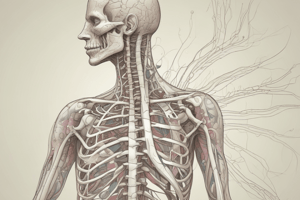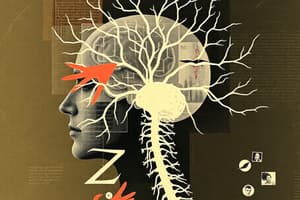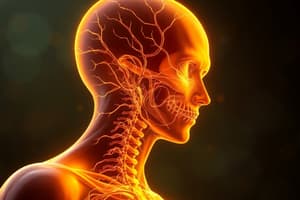Podcast
Questions and Answers
What is the primary function of the somatic nervous system?
What is the primary function of the somatic nervous system?
- To conduct sensory and motor impulses (correct)
- To prepare the body for emergencies
- To facilitate digestion and metabolic processes
- To regulate involuntary actions such as heart rate
Which plexus is responsible for providing connections to the thighs and calves?
Which plexus is responsible for providing connections to the thighs and calves?
- Cervical plexus
- Sacral plexus
- Brachial plexus
- Lumbar plexus (correct)
Which of the following best describes the role of the sympathetic nervous system?
Which of the following best describes the role of the sympathetic nervous system?
- It aids in digestion and energy restoration
- It maintains normal heart rate and blood pressure
- It conducts impulses from the CNS to voluntary muscles
- It prepares the body for fight or flight responses (correct)
How many pairs of spinal nerves are primarily involved in the PNS?
How many pairs of spinal nerves are primarily involved in the PNS?
What is the main difference between voluntary and involuntary actions in the nervous system?
What is the main difference between voluntary and involuntary actions in the nervous system?
Which nerve is responsible for the sensory function of the lateral half of the anterior forearm?
Which nerve is responsible for the sensory function of the lateral half of the anterior forearm?
What muscle is NOT innervated by the Axillary Nerve?
What muscle is NOT innervated by the Axillary Nerve?
What sensory function is associated with the Radial Nerve?
What sensory function is associated with the Radial Nerve?
Which nerve is primarily affected in Klumpke Palsy?
Which nerve is primarily affected in Klumpke Palsy?
What type of hand condition is primarily caused by the impairment of intrinsic hand muscles in Klumpke Palsy?
What type of hand condition is primarily caused by the impairment of intrinsic hand muscles in Klumpke Palsy?
Which function is NOT lost due to an upper brachial plexus injury (Erb’s Palsy)?
Which function is NOT lost due to an upper brachial plexus injury (Erb’s Palsy)?
Which nerve innervates the flexor muscles in the forearm?
Which nerve innervates the flexor muscles in the forearm?
Loss of sensation along the medial side of the arm is primarily related to injury to which nerve?
Loss of sensation along the medial side of the arm is primarily related to injury to which nerve?
Which nerve innervates the skin of the anterior scrotum in males?
Which nerve innervates the skin of the anterior scrotum in males?
What is the primary motor function of the Sciatic Nerve?
What is the primary motor function of the Sciatic Nerve?
Which sensory function is associated with the Obturator Nerve?
Which sensory function is associated with the Obturator Nerve?
The Superior Gluteal Nerve primarily innervates which muscles?
The Superior Gluteal Nerve primarily innervates which muscles?
Which nerve provides no sensory functions in the gluteal area?
Which nerve provides no sensory functions in the gluteal area?
Which nerve innervates the skin on the upper anterior thigh?
Which nerve innervates the skin on the upper anterior thigh?
What is the primary sensory function of the Common fibular portion of the Sciatic Nerve?
What is the primary sensory function of the Common fibular portion of the Sciatic Nerve?
Which muscles are innervated by the Femoral Nerve?
Which muscles are innervated by the Femoral Nerve?
What is the primary function of the T6-T12 thoracic nerves?
What is the primary function of the T6-T12 thoracic nerves?
Which spinal nerves are responsible for innervating the intercostobrachial nerve?
Which spinal nerves are responsible for innervating the intercostobrachial nerve?
Injury to which thoracic nerves typically results in normal hand and arm function?
Injury to which thoracic nerves typically results in normal hand and arm function?
Which lumbar nerve contributes to the iliohypogastric nerve's sensory function?
Which lumbar nerve contributes to the iliohypogastric nerve's sensory function?
What body area is affected by injury to T-2 and T-5 thoracic nerves?
What body area is affected by injury to T-2 and T-5 thoracic nerves?
Which nerve innervates the skin on the upper middle thigh?
Which nerve innervates the skin on the upper middle thigh?
Which segment of the thoracic nerves is primarily responsible for controlling the rib cage?
Which segment of the thoracic nerves is primarily responsible for controlling the rib cage?
In males, which structure does the ilioinguinal nerve provide sensory innervation to?
In males, which structure does the ilioinguinal nerve provide sensory innervation to?
What key function does the phrenic nerve serve?
What key function does the phrenic nerve serve?
Which cervical nerves are responsible for sensory innervation to the external ear?
Which cervical nerves are responsible for sensory innervation to the external ear?
What structure is formed by the anterior divisions of the superior and middle trunks in the brachial plexus?
What structure is formed by the anterior divisions of the superior and middle trunks in the brachial plexus?
Which nerve provides sensation to the anterior neck?
Which nerve provides sensation to the anterior neck?
Which of the following branches of the cervical plexus innervates the sternohyoid muscle?
Which of the following branches of the cervical plexus innervates the sternohyoid muscle?
Which component of the brachial plexus is specifically involved in dividing the roots into different trunks?
Which component of the brachial plexus is specifically involved in dividing the roots into different trunks?
Which cervical plexus nerve is responsible for providing sensation to the posterosuperior scalp?
Which cervical plexus nerve is responsible for providing sensation to the posterosuperior scalp?
How many trunks are formed at the base of the neck in the brachial plexus?
How many trunks are formed at the base of the neck in the brachial plexus?
Which part of the cervical plexus supplies the skin of the neck and upper thorax?
Which part of the cervical plexus supplies the skin of the neck and upper thorax?
Which structure connects the cervical plexus to the diaphragm?
Which structure connects the cervical plexus to the diaphragm?
Which nerve provides sensory innervation to the upper thoracic region and sternoclavicular joint?
Which nerve provides sensory innervation to the upper thoracic region and sternoclavicular joint?
What is the primary function of the Axillary nerve?
What is the primary function of the Axillary nerve?
Which trunk of the brachial plexus is formed exclusively by the C7 spinal nerve?
Which trunk of the brachial plexus is formed exclusively by the C7 spinal nerve?
Which nerve is specifically responsible for sensation to the posterosuperior scalp?
Which nerve is specifically responsible for sensation to the posterosuperior scalp?
Which of the following provides sensation to the external ear?
Which of the following provides sensation to the external ear?
Which muscle is affected by Klumpke Palsy leading to motor impairment?
Which muscle is affected by Klumpke Palsy leading to motor impairment?
In Klumpke Palsy, loss of sensation occurs primarily in which area?
In Klumpke Palsy, loss of sensation occurs primarily in which area?
What is a characteristic position of the arm in Erb's Palsy?
What is a characteristic position of the arm in Erb's Palsy?
Which nerve roots are primarily affected in Erb's Palsy due to excessive neck and shoulder angle?
Which nerve roots are primarily affected in Erb's Palsy due to excessive neck and shoulder angle?
Which of the following best describes the consequence of a lower brachial plexus injury?
Which of the following best describes the consequence of a lower brachial plexus injury?
Which of the following correctly describes the formation of the lateral cord in the brachial plexus?
Which of the following correctly describes the formation of the lateral cord in the brachial plexus?
What is the primary sensory function of the Ulna Nerve?
What is the primary sensory function of the Ulna Nerve?
Which of the following nerves innervates the teres minor muscle?
Which of the following nerves innervates the teres minor muscle?
What nerve is primarily affected in an upper brachial plexus injury (Erb's Palsy)?
What nerve is primarily affected in an upper brachial plexus injury (Erb's Palsy)?
Which trunk is formed solely by the root of C7 in the brachial plexus?
Which trunk is formed solely by the root of C7 in the brachial plexus?
What are the functions of the Musculocutaneous Nerve?
What are the functions of the Musculocutaneous Nerve?
Which of the following accurately describes the posterior cord of the brachial plexus?
Which of the following accurately describes the posterior cord of the brachial plexus?
What type of nerve injury is Erb's Palsy?
What type of nerve injury is Erb's Palsy?
Which segment of the thoracic nerves is primarily responsible for innervating the abdominal muscles?
Which segment of the thoracic nerves is primarily responsible for innervating the abdominal muscles?
What function do the T6-T12 thoracic nerves primarily assist with?
What function do the T6-T12 thoracic nerves primarily assist with?
Which thoracic nerve injury results in paraplegia with minimal control over bowel and bladder functions?
Which thoracic nerve injury results in paraplegia with minimal control over bowel and bladder functions?
Which of the following nerves primarily supplies sensations to the lateral half of the anterior thigh?
Which of the following nerves primarily supplies sensations to the lateral half of the anterior thigh?
Which function is NOT affected by an injury to the thoracic nerves T1-T5?
Which function is NOT affected by an injury to the thoracic nerves T1-T5?
Which lumbar nerve is primarily responsible for innervating the internal oblique and transversus abdominis muscles?
Which lumbar nerve is primarily responsible for innervating the internal oblique and transversus abdominis muscles?
The medial branches of which thoracic nerves pierce the rhomboid and trapezius muscles?
The medial branches of which thoracic nerves pierce the rhomboid and trapezius muscles?
Which thoracic nerve segments primarily affect the chest muscles?
Which thoracic nerve segments primarily affect the chest muscles?
Which portion of the Sciatic Nerve innervates the short head of the biceps femoris?
Which portion of the Sciatic Nerve innervates the short head of the biceps femoris?
What sensory area does the tibial portion of the Sciatic Nerve cover?
What sensory area does the tibial portion of the Sciatic Nerve cover?
Which nerve innervates the external urethral sphincter?
Which nerve innervates the external urethral sphincter?
Which of the following areas is innervated by the posterior femoral cutaneous nerve?
Which of the following areas is innervated by the posterior femoral cutaneous nerve?
Which muscle group is NOT innervated by the tibial portion of the Sciatic Nerve?
Which muscle group is NOT innervated by the tibial portion of the Sciatic Nerve?
Flashcards are hidden until you start studying
Study Notes
Spinal Nerves
- Peripheral Nervous System (PNS) connects the CNS to the body, conducting impulses.
- Comprises 31 pairs of nerves:
- 8 cervical nerves
- 12 thoracic nerves
- 5 lumbar nerves
- 5 sacral nerves
Voluntary & Involuntary Actions
- Voluntary (somatic): Actions like picking up objects.
- Involuntary (autonomic): Includes bodily functions such as heart rate and digestion.
- Sympathetic Nervous System: Responsible for 'fight or flight' response, increasing blood flow to muscles, heart rate, and blood pressure.
- Parasympathetic Nervous System: Promotes 'rest and digest' functions, directing blood flow to digestion and maintaining lower heart rates.
Plexuses
- Cervical plexus: Nerve connections to head, neck, and shoulder.
- Brachial plexus: Supplies skin and musculature of upper limbs.
- Lumbar plexus: Supplies the back, abdomen, and lower limbs.
- Sacral plexus: Innervates pelvis, buttocks, and lower legs.
Cervical Nerves
- 7 cervical vertebrae but 8 cervical nerves (C1-C8); C8 emerges below C7.
- Cervical plexus (C1-C4) consists of:
- Motor branches: Innervate neck and diaphragm muscles.
- Phrenic nerve (C3-C5): Crucial for diaphragm innervation.
- Sensory branches: Provide sensation to neck, upper thorax, scalp, and ear.
- Motor branches: Innervate neck and diaphragm muscles.
Brachial Plexus
- Comprises roots (C5-T1), trunks, divisions, cords, and branches.
- Superior trunk: C5-C6; Middle trunk: C7; Inferior trunk: C8-T1.
- Major branches include:
- Musculocutaneous Nerve: Innervates biceps and brachialis.
- Axillary Nerve: Innervates deltoid and teres minor.
- Median Nerve: Innervates flexor muscles and sensation to lateral palm.
- Radial Nerve: Innervates triceps and sensory to posterior arm.
- Ulnar Nerve: Innervates hand muscles and provides sensation to medial fingers.
Injuries
- Upper brachial plexus injury (Erb's Palsy): Affects C5-C6, impairing shoulder and arm movements.
- Klumpke Palsy: Involves T1 root, causing hand muscle paralysis and sensory loss on medial arm.
Thoracic Nerves
- 12 spinal nerves (T1-T12) control upper chest, mid-back, and abdomen.
- Anterior division: Intercostal nerves for rib control.
- Posterior division: Medial branches innervate upper back skin.
Lumbar Nerves
- 5 spinal nerves (L1-L5) form the lumbar plexus.
- Contains nerves like:
- Iliohypogastric and Ilioinguinal: Innervate abdominal muscles and skin in the pelvic regions.
- Genitofemoral: Innervates the cremasteric muscle and skin of the thigh.
- Femoral: Supplies quadriceps and provides sensation to the anterior thigh.
Sacral Nerves
- 5 pairs of nerves, including the sciatic nerve, which is crucial for lower limb movement and sensation.
- Major branches include:
- Superior Gluteal Nerve: Innervates gluteus minimus and medius.
- Sciatic Nerve: Tibial portion innervates posterior thigh muscles, while the common fibular portion innervates lateral and anterior leg muscles.
Cervical Nerves
- Greater Auricular nerve (C2, C3): Provides sensation to the external ear and parotid gland.
- Transverse Cervical nerve (C2, C3): Responsible for sensation to the anterior neck.
- Lesser Occipital nerve (C2): Supplies sensation to the posterosuperior scalp.
- Supraclavicular nerves (C3, C4): Convey sensation over the supraclavicular fossa and the upper thoracic region, including the sternoclavicular joint.
Brachial Plexus
- Consists of roots (C5-T1), trunks, divisions, cords, and branches, supplying the skin and musculature of the upper limb.
- Roots converge to form three trunks: Superior (C5-C6), Middle (C7), and Inferior (C8-T1).
- Trunks divide into anterior and posterior divisions within the posterior triangle of the neck, passing through the axilla.
Brachial Plexus Cords
- Three cords named for their position relative to the axillary artery:
- Lateral cord: Formed by anterior divisions of the superior and middle trunks.
- Posterior cord: Formed by posterior divisions of all three trunks.
- Medial cord: Formed by the anterior division of the inferior trunk.
Major Branches of Brachial Plexus
- Musculocutaneous Nerve (C5, C6, C7): Innervates biceps brachii and brachialis; sensory to lateral anterior forearm and a portion of the posterior forearm.
- Axillary Nerve (C5, C6): Innervates deltoid and teres minor; sensory to the inferior region of the deltoid ("regimental badge").
- Median Nerve (C6, C7, C8, T1): Supplies flexor muscles of the forearm and sensation to the lateral palm and lateral 3.5 fingers.
- Radial Nerve (C5, C6, C7, C8, T1): Innervates triceps and extensors of the wrist and fingers; sensory to the posterior arm and forearm.
- Ulnar Nerve (C8, T1): Innervates hand muscles; sensory to anterior and posterior surfaces of medial 1.5 fingers.
Brachial Plexus Injuries
- Erb's Palsy (Upper Brachial Plexus Injury): Affects C5-C6; leads to shoulder and arm movement impairments. Typical presentation includes "waiter's tip" position.
- Klumpke's Palsy (Lower Brachial Plexus Injury): Affects T1; causes hand muscle paralysis and sensory loss in the medial arm.
Thoracic Nerves
- Comprised of 12 spinal nerves (T1-T12) controlling the upper chest, mid-back, and abdomen.
- Anterior division forms intercostal nerves for rib control, and the posterior division innervates the upper back skin.
Functions of Thoracic Nerves
- T1-T5: Affect upper chest, mid-back, and abdominal muscles; control rib cage, lungs, diaphragm.
- T6-T12: Affect abdominal and back muscles; assist with balance, posture, coughing, and expulsion from airways.
Lumbar Nerves
- Formed by five spinal nerves (L1-L5) with branches innervating abdominal muscles and skin in pelvic regions.
- Lumbar Plexus: Includes important nerves, such as Iliohypogastric (L1), Genitofemoral, and Femoral nerves which innervate specific muscles.
Sciatic Nerve
- Comprised of Tibial (L4, L5, S1, S2, S3) and Common Fibular portions; innervates the posterior thigh muscles and provides sensory innervation to the foot.
- Sciatica refers to pain associated with dysfunction of the sciatic nerve.
Posterior Femoral Cutaneous and Pudendal Nerves
- Posterior Femoral Cutaneous (S1, S2, S3): Provides sensory functions to the posterior thigh and leg and perineal skin.
- Pudendal Nerve (S2, S3, S4): Innervates perineal skeletal muscles, external urethral and anal sphincters, and provides sensation to genitalia and perineum.
Studying That Suits You
Use AI to generate personalized quizzes and flashcards to suit your learning preferences.





